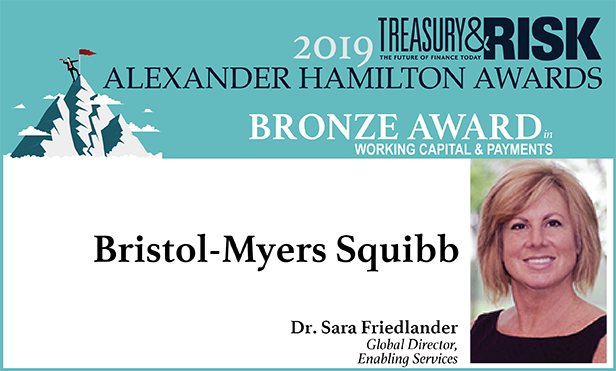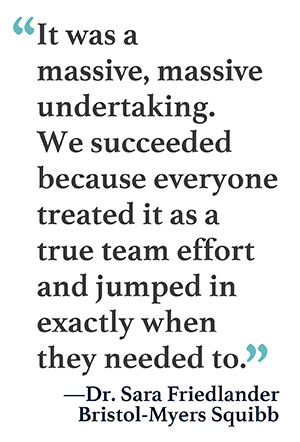
Bristol-Myers Squibb (BMS) is dedicated to discovering,developing, and delivering innovative medications to improve thehealth of patients around the world. A couple of years ago, thecompany's internal travel and entertainment expense (T&E)processes desperately needed an injection of efficiency. Employeeswho traveled on company business were given a corporate card.Unfortunately, the card was not widely accepted in some of theregions where the global biopharmaceutical firm had operations.
|Employees who traveled where the corporate card wasn't acceptedused their personal credit card to cover T&E, then expensedtheir purchases through BMS's expense management tool. Some becameso accustomed to this process that they started using personalcards for all expenses, even with vendors that would have acceptedthe corporate card. This was problematic because it reduced theability of sourcing managers to monitor corporate travelspending.
|“When accounting for expenses, we use a hierarchy of categoriesand subcategories,” says Dr. Sara Friedlander, the global directorof enabling services for Bristol-Myers Squibb, who is responsiblefor the company's travel sourcing and operations as well assourcing for strategic meetings. “When you are using a personalcard, you are relying on your colleagues to select the rightexpense type for each transaction, but they may not know exactlywhich category applies. Reconciling expenses to the right categorywas a never-ending task for my team, when they should have beendoing more strategic work. We needed to have the same people whowere actually making the purchases also correctly identifying whatthey were expensing.”
| BMS launched an initiative todevelop a new procurement solution. The project team held internalfocus groups and performed external benchmarking. They evaluatedprospective banking partners and discovered that Citi could supporttheir global travel and meeting-planning needs. BMS launched fournew payment methods, each of which supports a specific type ofsourcing for the company.
BMS launched an initiative todevelop a new procurement solution. The project team held internalfocus groups and performed external benchmarking. They evaluatedprospective banking partners and discovered that Citi could supporttheir global travel and meeting-planning needs. BMS launched fournew payment methods, each of which supports a specific type ofsourcing for the company.
First, the project team developed a virtual card account (VCA)program for meetings, working closely with Citi to tailor thebank's standard virtual card solution to meet their unique needs.They created custom data fields that provide information requiredto segregate expenses into buckets such as transportation, food,and meeting rentals. The data fields vary by geographic region,depending on what information each jurisdiction needs for taxpurposes. They also built in spending controls that enable theprocurement group to set an upper spending limit for each virtualcard.
|Now, when the company plans a meeting, the event is assigned aunique VCA card number. Internal meeting planners make largepurchases of products and services using that card number. Meetingplanners assign their purchases to the appropriate category andspend only until they reach the preapproved budget. The projectalso rolled out an automated process for invoicereconciliation.
|The second new payment method at BMS is a Citi travel card forindividual employees traveling to business meetings. “Anythingrelated to individuals' travel goes through the corporate travelcard,” Friedlander says. “Airfare, hotel, taxis or ride serviceslike Uber, and meals that you pay for—all go on your travel expensecard.” The card enables close tracking of employees' travel-relatedexpenses, and it works only with vendors of appropriate services.“You can't walk into a movie theater and use this card,”Friedlander says.
|Third, BMS rolled out a corporate purchasing card (p-card) thatis very similar to the travel card but can be used for low-budgetbusiness expenses such as office supplies.
|And fourth, the company implemented Citi's central travelaccount (CTA) solution, a globally available and centrally billedpayment tool. BMS uses the CTA solution for its typical meetingexpenses in areas of the world where Citi's VCA program is notaccepted, including Mexico, some South American countries, and someEastern European countries.
|
See also:
- On-demand webcast: How to Leverage Payment Innovations andEfficiencies
- Custom-Built Software Streamlines Currency-ControlsCompliance
- Centralizing Payments Across 100 Markets Around theWorld
- 2019 Alexander Hamilton Awards in TechnologyExcellence
|
BMS rolled out this entire program across 32 countries in justeight months. “It was a massive, massive undertaking,” Friedlandersays. “We succeeded because everyone treated it as a true teameffort and jumped in exactly when they needed to.”
|The project was also a categorical success. The globalacceptance of this combination of payment programs has virtuallyeliminated the need for employees to ever put business expenses ontheir personal card. Filling out expense reports used to take anaverage of 30 minutes per report, so eliminating the need tomanually enter travel expenses in the T&E tool is savingemployees across the company nearly 4,000 hours per year. At thesame time, the new payment options have significantly reduced therisk of manual data entry error or overspending.
Complete your profile to continue reading and get FREE access to Treasury & Risk, part of your ALM digital membership.
Your access to unlimited Treasury & Risk content isn’t changing.
Once you are an ALM digital member, you’ll receive:
- Critical Treasury & Risk information including in-depth analysis of treasury and finance best practices, case studies with corporate innovators, informative newsletters, educational webcasts and videos, and resources from industry leaders.
- Exclusive discounts on ALM and Treasury & Risk events.
- Access to other award-winning ALM websites including PropertyCasualty360.com and Law.com.
*May exclude premium content
Already have an account? Sign In
© 2024 ALM Global, LLC, All Rights Reserved. Request academic re-use from www.copyright.com. All other uses, submit a request to [email protected]. For more information visit Asset & Logo Licensing.







